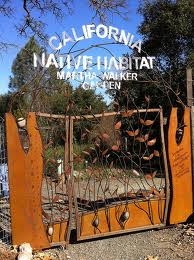
This month there are some wonderful opportunities to learn about, buy and plant natives. Our wet winters and dry summers are features we share with Mediterranean countries, and Napa native plants have learned to adapt to these conditions.
Many plants in the wild go dormant in the summer to conserve water, while others have leaves that deflect the summer heat to conserve what moisture they can glean. Native plants are diverse in type, from ground covers to tall trees. They are often water wise and deer resistant.
Natives can attract pollinators, birds and butterflies; fill difficult areas of your yard; and bring interest, color and even edibles to your garden.
If you are thinking about replacing a thirsty lawn, consider replanting with native grasses or grass-like plants. Native grasses have much more extensive root systems than typical turf grasses, so they are able to dive deep for moisture and nutrients during Napa’s long dry summers.
Grasses clean the air and sequester carbon deep in the soil. Deeply rooted grasses minimize erosion, soften the impact of rain water on soils and are part of the natural environment for native butterflies and birds.
To learn more about these underappreciated natives, join Bob Hornback, aka “The Grassman,” on Wednesday, April 10, from 7 p.m.to 8:30 p.m. at the Social Hall at Skyline Park in Napa. This event is sponsored by the Native Plant Society. For more details, call 707-253-2665 or visit www.napavalleycnps.org.
Planting under deciduous oaks or in partial shade can be a challenge, but here, too, natives offer some surprising choices. Consider currants such as Ribes sanguineum, a red currant with a cotton candy-pink flower. I planted several of these currants last year, and they are blooming beautifully in my garden now. Ribes ‘White Icicle’ is a white-blossomed albino currant; R. speciosum (fuchsia-flowering gooseberry) is a gorgeous currant, four to five feet in height, with deep pink, fuschia-like blossoms in spring.
Currants can take full sun, although in hot areas they appreciate some afternoon relief. They do well in partial shade, and some can grow six feet tall. Plant them where they will have room to thrive. Jam and jelly makers: water carefully to maximize your harvest. A mature bush can produce six to ten pounds of fruit in a season. Black currants are generally sweeter, while red and white currants may require a tad more sugar to balance their tartness. All make wonderful preserves.
For spring color, U. C. Davis native plant expert Kendra Baumgartner suggests white, blue and yellow Douglas iris (Iris douglasiana). They are deer resistant and bring color to shadier areas. These tough perennials grow back each year from thick white roots. You can divide them every couple of years to brighten more of your garden or to share with friends. Douglas iris are drought resistant, too.
For hot, sunny areas, consider Mimulus cardinalis (red monkeyflower). Its bright red flowers attract hummingbirds, and it is drought resistant and care free.
To see these and other natives, mark your calendar for the California Native Plant Society’s spring plant sale on Saturday, April 13, and Sunday, April 14, at Skyline Park. Call 707-253-2665 for more details.
When you arrive for the sale, stroll around the Martha Walker California Native Habitat Garden to see these beautiful plants in a garden setting. More than 200 native plants thrive in this special garden and are identified with markers. A walk through the Martha Walker Garden will give you an accurate picture of how large that small plant you just bought might grow.
Experts will be on hand to answer questions, and all proceeds go toward maintenance, improvements and educational programs in the park. Admission to both Skyline Park and the Martha Walker Garden is free during the sale.
Workshop: Napa County Master Gardeners will host a workshop on growing tomatoes on Saturday, April 13, from 9:30 a.m. to 11:30 a.m. at the Yountville Community Center, 6516 Washington Street, Yountville. Learn about tomato varieties that work well in Napa County. Learn when and how to plant; how to stake, water and feed; and how to handle common tomato pests and diseases. Register through Yountville Parks and Recreation: Mail in or Walk in registration (cash or check only). For fee and additional workshop information, (707) 944-8712 or visit the web site.
Master Gardeners are volunteers who help the University of California reach the gardening public with home gardening information. Napa County Master Gardeners (http://cenapa.ucdavis.edu) are available to answer gardening questions in person or by phone, Monday, Wednesday and Friday, 9 a.m. to Noon, at the U. C. Cooperative Extension office, 1710 Soscol Avenue, Suite 4, Napa, 707-253-4143, or from outside City of Napa toll-free at 877-279-3065. Or e-mail your garden questions by following the guidelines on our web site. Click on Napa, then on Have Garden Questions?